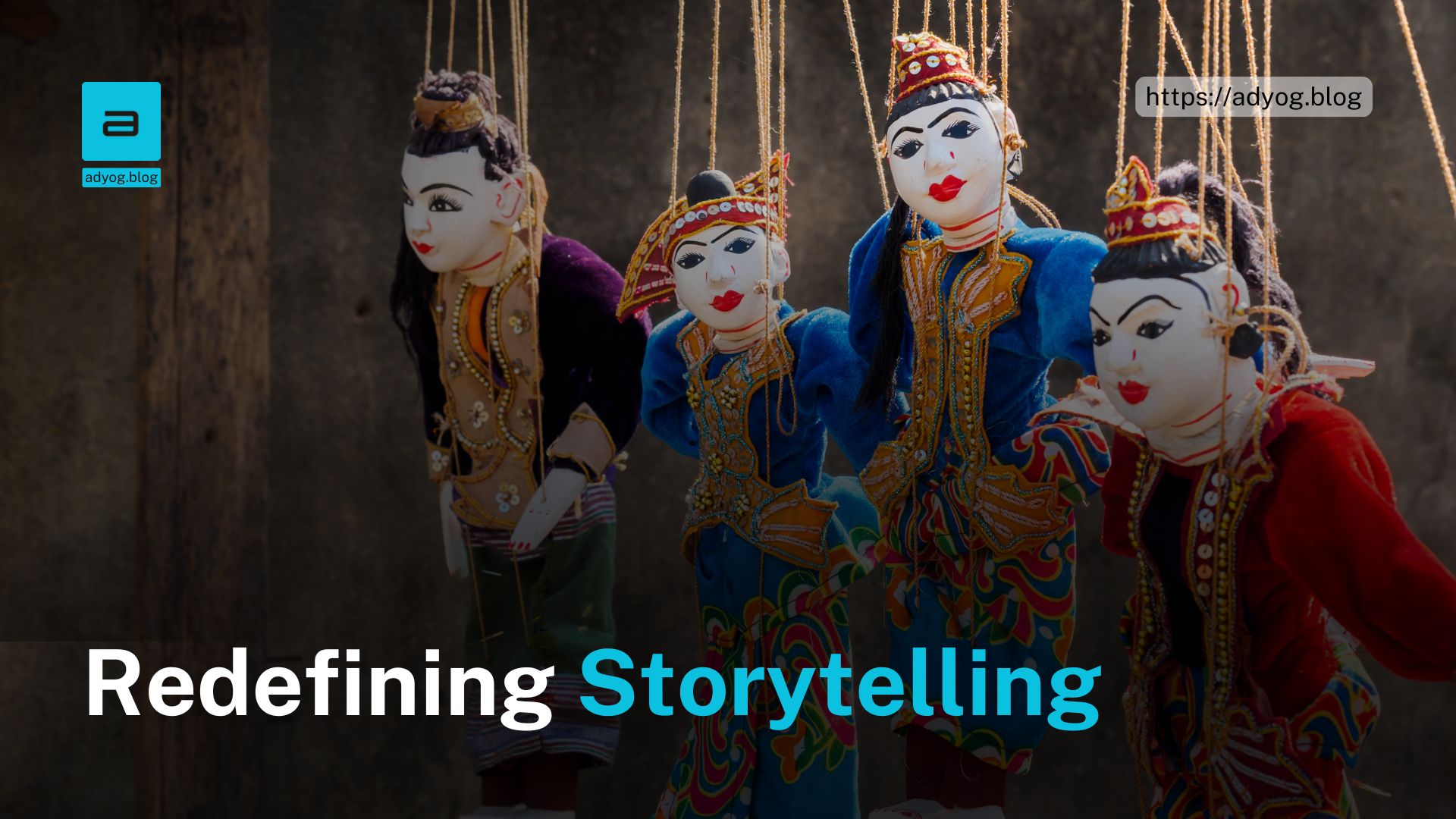Humans and AI are now co-creators of the storytelling revolution, marking a pivotal moment in how narratives are crafted and shared. Storytelling has always been humanity’s defining capability, shaping how we connect, preserve history, and dream of the future. As Yuval Noah Harari profoundly observes, “Homo sapiens rule the world because we create shared stories.”
Listen to the audio version, crafted with Gemini 2.0.
In 2025, this collaboration between humans and AI is transforming storytelling with tools like OpenAI’s GPT-4, Google Gemini, and Runway Gen-2. These technologies are democratizing creativity, empowering individuals to tell impactful stories once limited to professionals. This isn’t the replacement of human creativity—it’s its amplification. From education to entertainment, AI storytelling tools are enabling deeper engagement and unprecedented innovation.
This article delves into the current state of AI-powered storytelling, cutting-edge tools, research breakthroughs, cultural implications, and actionable strategies for harnessing this new storytelling revolution.
1. Content Is Storytelling: The Universal Thread
From the dawn of time, humans have been storytellers. Ancient myths, painted on cave walls, narrated the triumphs and fears of early civilizations. Religious texts wove moral codes into enduring tales, while oral traditions preserved the essence of cultures, passed down through generations. Wars told of strategy and sacrifice, fears warned of the unknown, and hopes inspired dreams of a better future. Humanity’s stories are not just records of history—they are the foundation of who we are.
Fast forward to today, and storytelling has evolved into countless forms:
- Blog posts share knowledge and discoveries.
- Social media crafts micro-narratives that shape perspectives in seconds.
- Videos immerse us in visual sagas, evoking emotions beyond words.
- Even advertisements, political speeches, and monumental achievements like landing on the moon are nothing more than stories crafted to inspire, persuade, or unite.
Storytelling is the thread that binds humanity across time and space, and now, with the advent of AI, this ancient art is reaching unprecedented heights. AI does not replace our stories—it elevates them. It transforms narratives from static to dynamic, from linear to immersive:
- AI turns the fear of global crises into simulations that educate and prepare.
- It revisits historical wars, crafting nuanced lessons that help us avoid the mistakes of the past.
- It amplifies hope, creating bridges across cultures and generations, fostering empathy and unity like never before.
2. AI: Elevating the Craft of Storytelling
AI storytelling tools are revolutionizing how stories are created, consumed, and experienced:
Key Transformations Enabled by AI:
- Democratization of Creativity:
AI tools like Runway Gen-2 allow individuals to produce high-quality video content previously reserved for Hollywood studios. - Real-Time Adaptation:
AI tools like Google Gemini dynamically adjust narratives based on audience reactions or preferences. - Personalized Storytelling:
GPT-4 generates tailored narratives, from bedtime stories for children to professional scripts for creators. - Immersive Story Worlds:
Luma AI and Unreal Engine enable the creation of explorable 3D environments, turning passive audiences into active participants.
Case Examples:
- A politician dynamically adjusts speeches using AI-driven sentiment analysis.
- An educator uses AI-generated simulations to let students “relive” historical events like the signing of the Declaration of Independence.
3. Storytelling Across Time: From Moon Landings to TikTok
Human history is a tapestry of stories. Every defining moment is a narrative that connects, inspires, and shapes us:
- The Moon Landing: A tale of ambition and triumph that united millions worldwide.
- Political Movements: Narratives of rebellion, unity, and the pursuit of justice, inspiring generations to seek change.
- TikTok Videos: Modern micro-stories that entertain, educate, and connect audiences globally.
Even the smallest everyday moments hold stories:
- Advertisements: Evoking emotions and shaping identity.
- Viral Tweets: Sparking conversations with compact reflections.
- Personal Experiences: Stories that resonate with universal truths.
AI amplifies these stories in ways once unimaginable:
- Historical Simulations: AI recreates events like the Moon Landing for immersive learning.
- Empowering Voices: AI helps marginalized communities share their stories globally.
- Personalized Narratives: Platforms tailor content to individual preferences, creating deeply engaging experiences.
Storytelling is the thread that binds humanity. With AI, this thread becomes a limitless canvas, enabling stories to transcend borders, resonate across cultures, and inspire generations to come.
4. The State of AI Tools in 2025: A Transformative Arsenal
The landscape of AI storytelling tools in 2025 has evolved into a cutting-edge ecosystem that empowers creators across industries, from education and healthcare to media and entertainment. Here’s a look at the most transformative tools available today, redefining the boundaries of storytelling:
Key AI Tools Revolutionizing Storytelling:
- GPT-4 by OpenAI: The Narrative Powerhouse
- Generates sophisticated, context-aware multimedia narratives.
- Tailored applications for education, healthcare, and industry-specific storytelling.
- Multimodal capabilities enable seamless integration of text and images into dynamic narratives.
- Google Gemini: The All-in-One Creativity Engine
- Combines text, video, and image generation with advanced reasoning and adaptability.
- Real-time interactivity allows for dynamically evolving narratives that respond to audience feedback.
- Perfect for creating interactive educational modules, immersive marketing campaigns, and adaptive storytelling.
- Runway Gen-2: Cinema in Your Pocket
- Democratizes video production, allowing creators to produce cinematic-quality visuals from simple text prompts.
- Multi-scene generation ensures consistency across video narratives, opening doors for indie filmmakers and marketing professionals.
- Ideal for social media, advertising, and entertainment projects with professional visual requirements.
- MidJourney 5.2 & Stable Diffusion XL: Visual Storytelling Reimagined
- Empower creators to generate stunning, photorealistic visuals, from landscapes to intricate character designs.
- Simplify the creative process for design-heavy projects, bridging the gap between concept art and production.
- Used widely in publishing, advertising, and immersive gaming to create compelling visual content.
- Luma AI: Immersive 3D World-Building
- Creates explorable 3D environments from simple text prompts.
- Enables the creation of virtual worlds for education, gaming, and architectural simulations.
- Facilitates hands-on learning experiences, such as recreating ancient civilizations or exploring futuristic cityscapes.
Advanced Features Redefining Storytelling
- Text-to-Video Generation
- Tools like Runway Gen-2 allow creators to bring scripts and concepts to life through professional-grade video content.
- Multi-Modal Integration
- Gemini and GPT-4 seamlessly combine text, audio, and video to create cohesive, immersive narratives.
- Dynamic Interactivity
- AI platforms enable real-time adaptations, tailoring stories based on user input or audience sentiment.
- 3D and AR Environments
- Luma AI and similar tools are transforming storytelling into an immersive experience by making interactive, explorable 3D worlds accessible to all.
- Collaborative Creativity
- Advanced AI platforms support collaborative workflows, enabling teams to co-create and refine narratives across geographies in real time.
Why These Tools Matter for Big Projects
For large-scale projects in film, advertising, gaming, or education, these tools are revolutionizing every phase of storytelling:
- Conceptualization: AI enables faster prototyping of ideas, reducing the time from concept to execution.
- Production: High-quality visuals, videos, and narratives can be generated at a fraction of traditional costs.
- Personalization: Stories can now be tailored to audiences in real time, enhancing engagement and emotional resonance.
- Scalability: Teams can produce content at scale without compromising quality, enabling global campaigns or immersive educational initiatives.
2025 isn’t just a milestone for the evolution of AI storytelling tools—it’s a turning point where creators, armed with these transformative capabilities, are rewriting the future of narratives on a scale humanity has never seen before.
5. Research Breakthroughs on the Horizon: What’s Coming Next
Capabilities Expected Soon:
- Real-Time Multimodal Storytelling:
AI systems will seamlessly combine text, video, and sound, responding dynamically to audience engagement. - Emotionally Intelligent AI:
Future tools will generate deeply nuanced emotional content. - Hyper-Personalized Media Streams:
AI will curate entirely unique storylines for individual viewers based on their preferences and history. - AI-Generated 3D Worlds:
Entire environments will be generated from simple descriptions, enabling immersive learning and entertainment experiences.
6. Transformative Applications Across Industries
Education and Learning: Bringing History to Life
Imagine studying the moon landing not through a textbook, but by standing on the lunar surface in an AI-generated simulation. AI is revolutionizing education by making learning experiences immersive, interactive, and personalized.
- Dynamic Curriculums: Lessons tailored to individual students’ needs and learning styles.
- Interactive History: Students participate in AI-driven reenactments of historical events.
- Lifelong Learning: Story-driven AI platforms guiding adults through professional upskilling.
Workplace Innovation: Data-Driven Narratives
Every business decision is a story waiting to be told. AI helps organizations craft compelling narratives from data, turning complex information into actionable insights.
- Training Simulations: Employees role-play real-world challenges in AI-generated scenarios.
- Collaboration Tools: AI bridges global teams with real-time, adaptive communication platforms.
Art, Media, and Entertainment: Stories Without Limits
From indie creators producing Hollywood-level content to games with adaptive plotlines, AI is fueling an explosion of creativity.
- Interactive Games: AI generates unique plotlines tailored to individual players.
- Virtual Influencers: AI personas are redefining marketing, offering cost-effective, dynamic engagement.
7. Practical Implementation Guidance for AI Storytelling
Building a Framework for AI-Driven Creativity
To fully harness AI storytelling tools, creators must adopt a structured, iterative approach that blends technical proficiency, creative expertise, and ethical responsibility. Here’s a nuanced roadmap for successfully implementing AI in storytelling:
Technical Implementation Roadmap
- AI Tool Mastery: Navigating the Landscape
- Identify the most suitable platforms for your goals (e.g., GPT-4 for narratives, Runway Gen-2 for videos, or MidJourney for visual storytelling).
- Evaluate tools based on scalability, user-friendliness, and integration with existing workflows.
- Experiment with APIs and plugins to extend platform capabilities for unique projects.
- Creative Workflow Design: Orchestrating Human-AI Collaboration
- Develop a cyclical process where human creators provide vision and AI assists in execution.
- Encourage iterative feedback: AI generates drafts; creators refine for tone, nuance, and authenticity.
- Use AI to handle repetitive tasks (e.g., generating dialogue options or scene transitions), freeing up humans for high-level creativity.
Skill Development Path
- Foundational Learning: Setting the Groundwork
- Familiarize yourself with the basics of AI storytelling tools, prompt engineering, and ethical principles.
- Understand AI’s strengths and limitations—knowing when to let it assist and when human input is essential.
- Advanced Techniques: Scaling Creativity
- Explore multi-modal content creation, combining text, video, and audio for richer storytelling experiences.
- Master adaptive storytelling techniques that adjust narratives dynamically based on user input or audience behavior.
- Expert Level: Innovating with AI
- Train custom AI models tailored to specific storytelling styles, genres, or audience demographics.
- Leverage fine-tuning to align AI-generated content with unique brand voices or creative visions.
- Integrate AI into complex production pipelines, from ideation to post-production.
Key Considerations for Implementation Success
- Iterative Testing and Feedback Loops: Embrace a test-and-learn mindset to continuously improve AI outputs.
- Human Oversight: Maintain a “human-in-the-loop” system to ensure AI-generated content aligns with ethical and cultural expectations.
- Scalability: Plan for future growth by selecting tools and workflows that can scale with evolving creative needs.
By blending these strategies, creators can transform their workflows and unlock the full potential of AI storytelling tools, ensuring that every narrative is impactful, engaging, and human-centric.
8. Cultural and Ethical Considerations in AI Storytelling
Challenges:
- Bias in AI-generated content.
- Ownership and consent in creative work.
Proposed Solutions:
- Transparent disclosure of AI involvement.
- Continuous audits for fairness and inclusivity.
9. Global Perspectives: AI Storytelling Across Cultures
AI storytelling varies globally due to linguistic and cultural differences. Key opportunities include:
- Preserving endangered languages.
- Amplifying marginalized voices.
- Enabling cross-cultural storytelling collaborations.
10. Future Directions: AI Creativity Beyond 2025
Predictions for 2030:
- Holographic Storytelling: Fully immersive 360-degree narratives.
- Emotionally Adaptive Media: Stories that evolve in real-time based on audience emotions.
- Global Collaboration Platforms: Decentralized ecosystems connecting storytellers worldwide.
Conclusion: AI and Humanity—Co-Creators of the Future
Storytelling defines humanity—and AI is amplifying this superpower. By combining human creativity with AI’s capabilities, we are shaping a future of unprecedented narrative possibilities. With vigilance and collaboration, we can ensure AI enriches storytelling, empowering us to tell better, more impactful stories for generations to come.
References
- OpenAI (GPT-4):
Multimodal AI for text and image storytelling. OpenAI - Google Gemini:
Adaptive storytelling integrating text, video, and image. Google AI - Runway Gen-2:
High-quality video creation from prompts. Runway - MidJourney & Stable Diffusion XL:
Photorealistic visual generation. MidJourney | Stability AI - Pika Labs:
AI-driven 3D video and interactive environments. Pika Labs - Luma AI:
Immersive 3D environments for education and media. Luma AI - Hyper-Personalized Media:
McKinsey’s 2025 Media Futures Report on tailored AI content. - Emotionally Intelligent AI:
AI for nuanced emotional narratives (Oxford 2023 study). - Interactive Storytelling Networks:
UNESCO initiatives for collaborative AI storytelling. - AI-Generated 3D Worlds:
Procedural content discussed at SIGGRAPH 2025. - Bias Mitigation Techniques:
Ethical AI frameworks by Mozilla Foundation. - Emotionally Adaptive Media:
DARPA’s research on real-time emotion-aware interfaces.





Leave a Reply